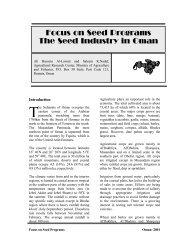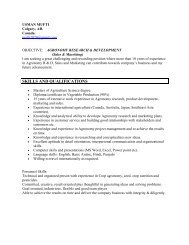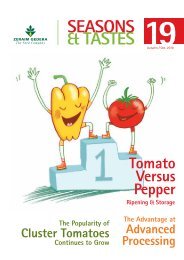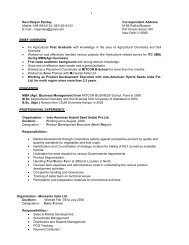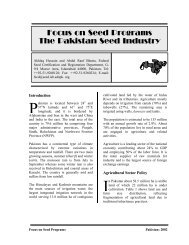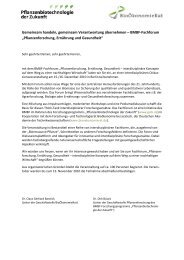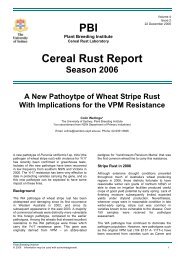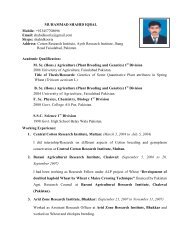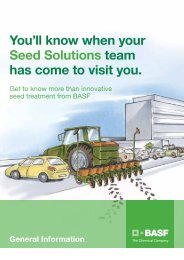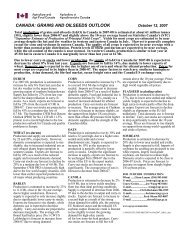The Ethiopian seed industry - SeedQuest
The Ethiopian seed industry - SeedQuest
The Ethiopian seed industry - SeedQuest
Create successful ePaper yourself
Turn your PDF publications into a flip-book with our unique Google optimized e-Paper software.
2<br />
horticultural crops to as large as 4000 ha for<br />
field crops.<br />
At present approximately 8 million ha is<br />
used to produce the main food crops:<br />
cereals, legumes and oil<strong>seed</strong>s (Table 1).<br />
Cereals [tef (Eragrostis tef), maize, barley,<br />
wheat and sorghum] occupy 80 to 85% of<br />
the total cultivated area, followed by<br />
legumes and oil <strong>seed</strong>s. <strong>The</strong> area annually<br />
covered by major cereal crops are 2.1, 1.6,<br />
1.4, 0.9 and 0.8 million ha for tef, maize,<br />
sorghum, wheat and barley, respectively.<br />
Pulses (faba bean, field peas, haricot bean,<br />
chickpea, grass pea, lentil) occupy 1 million<br />
ha and oil<strong>seed</strong> crops [niger <strong>seed</strong> (Guzotia<br />
abyssinica), lin<strong>seed</strong>, rape<strong>seed</strong>, peanut,<br />
sunflower, sesame and castor bean] about<br />
0.4 million ha.<br />
Table 1. Area and production of major crops from 1997/98 to 1998/99<br />
Area in ha<br />
Production in tonnes Productivity in tonnes<br />
Crops<br />
(000)<br />
(000)<br />
1997/98 1998/99 1997/98 1998/99 1997/98 1998/99<br />
Cereals 5601.88 6744.73 6498.80 7683.00 1.16 1.14<br />
Legumes 837.60 875.38 680.20 931.98 0.81 0.84<br />
Oil<strong>seed</strong>s 383.50 374.78 164.49 156.75 0.45 0.43<br />
Others 29.71 21.43 16.22 12.13 0.55 0.57<br />
All crops 6852.69 8016.32 9645.23 7359.71 1.07 1.07<br />
Source: Central Statistics Authority (CSA), Bulletin Nos. 171 (1997), 189 (1998) and 200 (1999)<br />
Despite an abundant arable land the country<br />
is not self-sufficient in food production,<br />
though it was a net exporter of food grains<br />
until late 1950s. Agricultural growth<br />
averaged 2.2% in 1960s, 0.7 in 1970s and<br />
0.5% in the 1980s. This is attributable to<br />
government policy, low level of technology<br />
in the predominantly traditional sector of<br />
agriculture that comprises about 96% of the<br />
main crop area, and lack of modern inputs.<br />
In the 1990s the agricultural sector has<br />
responded positively to reforms aimed at<br />
enhancing market incentives and private<br />
sector initiatives. <strong>The</strong>re has been progress in<br />
both the production and productivity of the<br />
traditional sector of agriculture through<br />
provision of modern inputs such as <strong>seed</strong>s,<br />
fertilizers, pesticides and farm implements.<br />
<strong>The</strong> Government policy and strategy is<br />
aimed at broadening the agricultural<br />
production base by improved productivity<br />
and support to research, extension,<br />
infrastructure, irrigation and the private<br />
sector.<br />
National Seed Policy and Laws<br />
In Ethiopia formal <strong>seed</strong> production can<br />
be dated back to the opening of Jimma<br />
Agricultural College (JAC, 1942),<br />
Alemaya University of Agriculture<br />
(AUA, 1954), <strong>Ethiopian</strong> Agricultural<br />
Research Organization (EARO, 1966) and<br />
the Chilalo Agricultural Development Unit<br />
(CADU, 1967). <strong>The</strong> <strong>Ethiopian</strong> <strong>seed</strong><br />
program, however, was very much ad hoc<br />
and <strong>seed</strong> production was uncoordinated until<br />
the late 1970s.<br />
Focus on Seed Programs<br />
2001: Ethiopia



